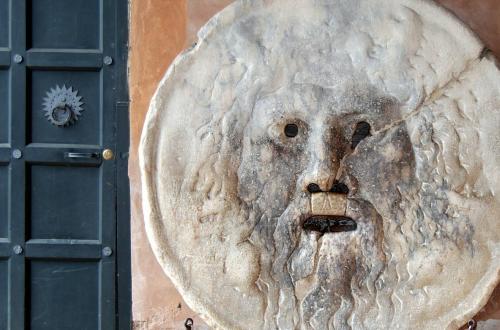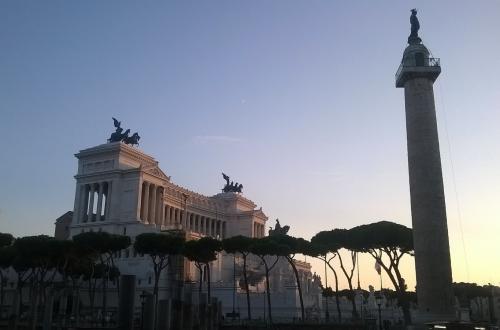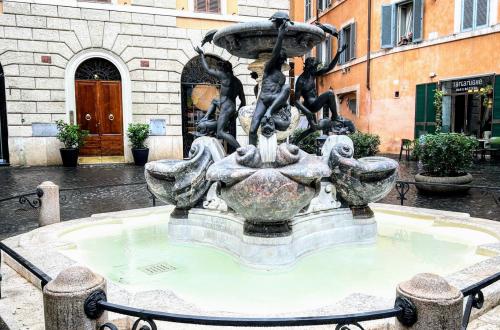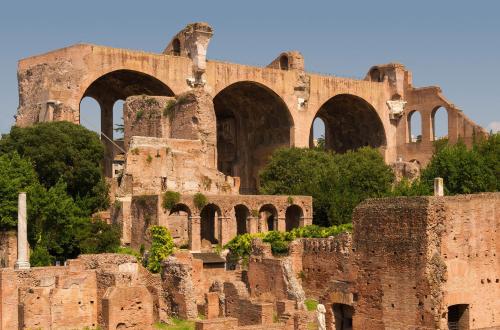L’Amphithéâtre Flavio (Colisée)

 Condividi
Condividi
The current Palazzo Ginnasi is the building that replaces the old Palazzo Ginnasi, partially demolished between 1935 and 1940 when the street was widened, of which it still retains the two coats of
[...]Palazzo Incontro is a historic building in Rome, located in the Campo Marzio district, built in the second half of the 18th century, exactly in 1765 by the architect Giovanni Paolo Burij.
It was build at the end of the 16th century by Cardinal Scipione Lancellotti, who commissioned it to Francesco da Volterra and was completed by Carlo Maderno.
The palace dates back to the early seventeenth century and belonged to the Maccarani family; in the second half of the 17th century it was purchased by the Odescalchi Princes, who still own it, and
[...]The Palace, now the headquarters of the Banco di Sicilia, was built in 1662 to a design by Carlo Rainaldi for the Duke of Nevers, Filippo Giuliano Mazzarino Mancini.
Its name was taken from a statue of the god Mars found in the foundation excavations and mistakenly believed to be a representation of the leader Pyrrhus, king of Epirus, defeated by the Romans in
[...]In 1508 Luigi De Torres had the palace built by the Neapolitan architect Pirro Ligorio to make it the family palace.
The building, located in Piazza Paganica, was erected in 1541 at the behest of Ludovico Mattei, Duke of Paganica, to a design attributed to Nanni di Baccio Bigio.
The Sangallo Medici Clarelli Palace was built by Antonio da Sangallo the Younger (1483-1546) together with his co-worker Dosio around 1535 as his private residence.
The palace was built in 1660 by De Rossi, a pupil of Bernini, probably on the occasion of the marriage of Pompeo Muti Papazzurri to Maria Isabella Massimo.
The palace was built in 1660 by the architect Giovanni Antonio De Rossi, based on a design by Bernini, and commissioned by the Marquis Francesco Nuñez Sanchez.
The original core of the palace dates back to the 15th century, when it was the residence of the Benzoni family.
Located in the area of the High Speed Station named after Camillo Benso Conte di Cavour, in the Tiburtina area, the building houses the new BNL Gruppo BNP Paribas headquarters.
Built in 1605 on the ruins of the baths of Constantine by Flaminio Ponzio for cardinal Scipio Borghese, it was embellished by Giovanni Vasanzio with a sloping terraced garden.
The palace was built at the end of the 16th century by an unknown family, whose abraded coat of arms can be seen on the cornice and in the courtyard, on the site of the Melangolo Tower, shown on Bu
[...]The original structure of the Palace dates back to a modest house that Gaspero dei Garzoni di Jesi purchased in 1512 from Alfonsina Orsini and which was modified in a series of works carried out at
[...]Il Ministero delle Imprese e del Made in Italy ha sede nello storico Palazzo Piacentini, realizzato da due figure di spicco del panorama architettonico italiano: M
[...]The present Palazzo Pichi Manfroni Lovatti is a copy of the original building by Gerolamo Pichi demolished in 1881 for the construction of Corso Vittorio Emanuele II.
It was built in 1450 on the ruins of Pompey's Theatre by Cardinal Francesco Condulmer, nephew of Pope Eugene IV Condulmer (1431-47).
Palazzo Maffei Marescotti is a vast palace, born as a noble palace, located in the Pigna district, on the corner between via dei Cestari and via della Pigna, adjacent to the Church of the Santissim
[...]The construction of the palace dates back to the 16th century; it first belonged to the Gottifredi family - this ownership is still indicated in Nolli's 1748 plan - then, at the end of the 18th cen
[...]Built at the beginning of the sixteenth century for the noble Calcagni family, it then passed to the Del Bene family, who were probably responsible for the painted façade on the Piazza Ricci side,
[...]The building has eighteenth-century shapes enlivened by the double portal with columned balcony and the tympanums of the windows on the main floor.
This is the most imposing palace in Via Giulia, designed and built by Antonio da Sangallo the Younger (1483-1546), whose residence it was, as indicated by the inscription on the left of the balcony
[...]Luogo culturale in divenire, Palazzo San Felice, attualmente in cantiere, sarà futura sede della Biblioteca di Archeologia e Storia dell’Arte.Il progetto di trasformazione del complesso architetton
[...]The Santacroce family owned several houses between the S. Angelo and Regola districts as early as the 15th century, including the palace where the Monte di Pietà was later established.
The Palace was built towards the end of the 16th century.
This palace is one of the best examples of Roman civil architecture of the late 16th century; built on commission by Ottaviano Crescenzi to a design by Giacomo Della Porta (1540-1602), it was howev
[...]
 Condividi
Condividi

 Condividi
Condividi

 Condividi
Condividi

 Condividi
Condividi

 Condividi
Condividi

 Condividi
Condividi